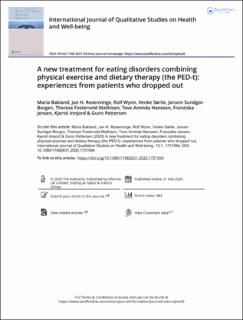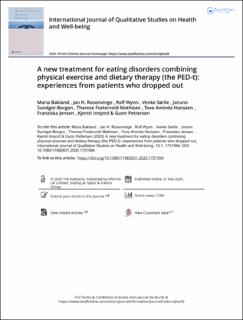| dc.contributor.author | Bakland, Maria | |
| dc.contributor.author | Rosenvinge, Jan H | |
| dc.contributor.author | Wynn, Rolf | |
| dc.contributor.author | Sørlie, Venke | |
| dc.contributor.author | Sundgot-Borgen, Jorunn | |
| dc.contributor.author | Mathisen, Therese Fostervold | |
| dc.contributor.author | Hanssen, Tove Aminda | |
| dc.contributor.author | Jensen, Franziska | |
| dc.contributor.author | Innjord, Kjersti | |
| dc.contributor.author | Pettersen, Gunn | |
| dc.date.accessioned | 2021-02-22T09:13:32Z | |
| dc.date.available | 2021-02-22T09:13:32Z | |
| dc.date.created | 2020-02-21T12:54:33Z | |
| dc.date.issued | 2020 | |
| dc.identifier.citation | International Journal of Qualitative Studies on Health and Well-being. 2020, 15 (1), . | en_US |
| dc.identifier.issn | 1748-2623 | |
| dc.identifier.uri | https://hdl.handle.net/11250/2729394 | |
| dc.description.abstract | Purpose: Eating disorders (ED) are complex and severe illnesses where evidence-based treatment is needed to recover. However, about half of the patients with ED do not respond to treatments currently available, which call for efforts to expand the portfolio of treatments. The aim of this study was to explore experiences from patients who dropped out of a new treatment for bulimia nervosa and binge ED, combining physical exercise and dietary therapy (PED-t). Methods: We conducted open-ended face-to-face interviews. The interviews were transcribed verbatim and the data were analysed with a phenomenological hermeneutical approach. Results: Three themes emerged: “standing on the outside”, “unmet expectations” and “participation not a waste of time”. Feelings of standing on the outside were elicited by being different from other group members and having challenges with sharing thoughts. Unmet expectations were related to treatment content and intensity, as well as the development of unhealthy thoughts and behaviours. Finally, some positive experiences were voiced. Conclusion: A need to clarify pre-treatment expectations and refining criteria for treatment suitability is indicated. The findings have contributed to the chain of clinical evidence regarding the PED-t and may lead to treatment modifications improving the treatment and thereby reducing drop out. | en_US |
| dc.language.iso | eng | en_US |
| dc.relation.uri | https://www.tandfonline.com/doi/full/10.1080/17482631.2020.1731994 | |
| dc.rights | Navngivelse 4.0 Internasjonal | * |
| dc.rights.uri | http://creativecommons.org/licenses/by/4.0/deed.no | * |
| dc.subject | Bulimia nervosa | en_US |
| dc.subject | Kvalitativ forskning | en_US |
| dc.title | A new treatment for eating disorders combining physical exercise and dietary therapy (the PED-t): experiences from patients who dropped out | en_US |
| dc.type | Peer reviewed | en_US |
| dc.type | Journal article | en_US |
| dc.description.version | publishedVersion | en_US |
| dc.source.pagenumber | 7 | en_US |
| dc.source.volume | 15 | en_US |
| dc.source.journal | International Journal of Qualitative Studies on Health and Well-being | en_US |
| dc.source.issue | 1 | en_US |
| dc.identifier.doi | 10.1080/17482631.2020.1731994 | |
| dc.identifier.cristin | 1796492 | |
| cristin.ispublished | true | |
| cristin.fulltext | original | |
| cristin.fulltext | original | |
| cristin.qualitycode | 1 | |


